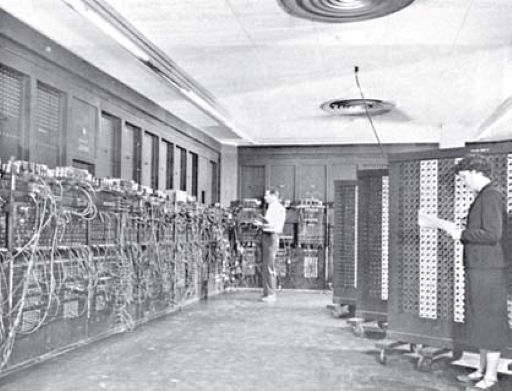1 The first computers
The computers which form the basis of those used today were mainly developed in the 1940s. The following quote taken from that era shows how difficult it was to conceive of the way in which computers would develop in the following decades.
I think there is a world market for maybe five computers.
Even later on, in the mid 1970s, some still failed to comprehend the size of the future computer market.
There is no reason for any individual to have a computer in his home.
And although a diminution in size was anticipated, it was considerably underestimated.
Where a calculator on the ENIAC is equipped with 18 000 vacuum tubes and weighs 30 tons, computers in the future may have only 1000 vacuum tubes and perhaps weigh 1½ tons.
Or, as this ABC News report from 1974 asserts: ‘One day, a computer will fit on a desk’. Watch the report at the following link:
One day, a computer will fit on a desk [Tip: hold Ctrl and click a link to open it in a new tab. (Hide tip)]
Figure 1 shows a picture of the ENIAC computer mentioned above. You can see it is rather larger than the personal computer available today! Completed in the US in 1945, it was one of the earliest electronic computers. Its name stands for Electronic Numerical Integrator And Calculator, and it was designed to calculate ballistic firing tables in the Second World War. It could perform mathematical operations such as addition, subtraction, multiplication and division, and it could find square roots and compare two values for equality.
As part of the ENIAC fiftieth anniversary celebrations, students and staff at the University of Pennsylvania fabricated a version of this computer using modern manufacturing processes. The component at the heart of this later version measures 7.44 millimetres by 5.29 millimetres! A personal computer was connected to this component to provide the modern equivalent of the cable connections shown on the left-hand side of Figure 1 and display the ENIAC’s outputs.
Computers like ENIAC were built because of the need for powerful automatic calculators. Another famous series of early programmable electronic computers were the Colossus machines created and used at Bletchley Park in the UK dedicated to breaking codes produced by the German cipher machines known as Lorenz machines used in the Second World War. The fundamental components of a computer have not changed since these first room-sized machines.

